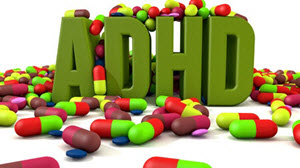 Attention deficit hyperactivity disorder (ADHD) is big business. ADHD medication sales have grown about 8 percent each year since 2010 and are projected to grow at least 13 percent this year to a whopping $12.9 billion in sales. There are two major reasons for this: First, the Affordable Care Act (ACA) and Medicaid now mandate that insurance providers cover mental health services — including behavioral disorder assessment and treatment. Second, adult diagnosis has exploded since the DSM-5 now incorporates specific symptom descriptions of adult ADHD in the manual, setting aside the notion that ADHD is only a child and adolescent syndrome.
Attention deficit hyperactivity disorder (ADHD) is big business. ADHD medication sales have grown about 8 percent each year since 2010 and are projected to grow at least 13 percent this year to a whopping $12.9 billion in sales. There are two major reasons for this: First, the Affordable Care Act (ACA) and Medicaid now mandate that insurance providers cover mental health services — including behavioral disorder assessment and treatment. Second, adult diagnosis has exploded since the DSM-5 now incorporates specific symptom descriptions of adult ADHD in the manual, setting aside the notion that ADHD is only a child and adolescent syndrome.
Evaluation
I recommend that the first evaluation be conducted over one hour, or maybe an hour and a half, especially when assessing children and adolescents. If behavioral intervention only is the treatment of choice, weekly sessions are advisable. If medication is employed, a one-month trial is appropriate. If the patient is doing well after a month, have the individual come back two months later, and if continuing to do well, see the person every three months, assessing for improvement (or the lack thereof) along the way.
History
Start by asking about the patient’s course of education and assess to what extent their social skills are impaired. Inquire specifically about what sort of struggles the person has had with school. Hallmark, core symptoms of ADHD are school failure and poor grades. Issues of school failure tend to escalate — less acute in grade school, junior high and even high school, but considerably more evident at the college level. With adults, ask about work history. How well are they performing at work? Ask about how performance evaluations have turned out. Have they changed jobs multiple times in the last year or two? Family history is important too. Frequently you will find yourself seeing patients whose siblings and parents have been diagnosed with ADHD. Genetic predisposition is very important from an evaluation perspective.
Indicators That Can Fly Under the Radar
Examine how patients fill out your paperwork. Did they overlook questions that they clearly should have seen? Does one of your forms contain boxes that were checked incorrectly? During the interview, ask, “How often do you misplace your keys; how often do you lose them?” “How many cellphones have you had to replace?” “Are you able read a book comfortably without your mind wandering or becoming restless?” I’ve had countless patients tell me they’ve never been able read a book in their life — from start to finish. It is imperative to assess for impairment in multiple domains of life. And be aware of the high rates of comorbidity with bipolar, depression, anxiety disorders and substance abuse. Incomplete responses to treatment for these disorders may be another sign of ADHD that can be easily overlooked. For example, a patient alluding to restlessness as a symptom, may have been diagnosed as having anxiety, when upon further review, the patient doesn’t have an anxiety disorder at all, but is actually describing a symptom of ADHD.
Medication Treatment
There are many different and distinct medications and formulations for treating ADHD nowadays. So if you’re a prescriber or a clinician wanting to know more about the various medications options, here’s my recommendation. Start by familiarizing yourself with one or two drugs and delivery systems in both the amphetamine and methylphenidate category. Adderall, in the amphetamine category, and Ritalin in the methylphenidate category are universal favorites. Then spread your wings and invest some time in learning about some of the newer agents – Vyvanse, the Daytrana patch, Tenex and Intuniv.
When confronted with the decision as to choosing between Adderall and Ritalin, keep in mind that regardless of what science and studies and the pharmaceutical companies say, you won’t know a thing until the patient swallows the first pill (unless the patient has had a previous adverse experience with a particular medication in the past). So just make a choice and get started. Assess the results and then either stay the course, with dosage adjustments, or switch to the other category.
From a dosing perspective, for most of the amphetamine formulations like Adderall, shoot for a target dose of 0.5mg/kilo. Therefore, with an 80 kilogram or 175 pound male, proceed this way: Start him lower beginning at 10mg in the morning and 10mg midday. See how he responds, and if favorably, increase to 20mg in the morning and 20mg midday, with 40mg daily as the target dose. With the methylphenidate (or Ritalin) drugs, aim for 1mg/kilo.
Sometimes using longer acting preparations in these two drug categories are the way to go to see if side effects become more tolerable, especially insomnia. Adderall XR, Focalin XR, Concerta and Ritalin LA are all fine possibilities.
The most commonly reported side effects of stimulant use are appetite loss and insomnia. At medication initiation, it’s also common for users to feel restless, jittery and a bit more sweaty than usual. Thus the importance of going slow — easing the patient into higher dosing in weekly intervals, as necessary. As for insomnia, many patients report that it improves through treatment because their “racing thoughts” when trying to sleep are slowing down via the medication.
Possible Abuse and Diversion
 About all you can do here is to emphasize to the fullest the importance of keeping these medications under lock and key. This is especially important for college students living in dorms or apartments to understand. And as part of your treatment agreement with these patients, have them sign a controlled substance use policy and make it clear as day that no additional medication will be prescribed because of extenuating circumstances, whatever they may be. Period.
About all you can do here is to emphasize to the fullest the importance of keeping these medications under lock and key. This is especially important for college students living in dorms or apartments to understand. And as part of your treatment agreement with these patients, have them sign a controlled substance use policy and make it clear as day that no additional medication will be prescribed because of extenuating circumstances, whatever they may be. Period.
Behavioral Treatment
The core symptom of ADHD is distractibility and this affects all age groups with the disorder in similar and yet different ways depending on age. The similarities include an inability to consistently focus on a task at hand accompanied often by very poor organizational skills. As such, the cornerstone of behavioral treatment is helping the individual develop and consistently maintain a set of organizational skills that enhances their daily functioning. For children and adolescents, this means simplifying their living and study environment by arranging it in such a way to help them focus better. For adults, this means learning how to prioritize better, manage time more efficiently and scheduling their day in such a way to effectively meet the demands of work and family.
Everyone affected by ADHD has to establish solid routines throughout the day. Creating to-do lists, a daily reminder system, a calendar of important events, deadlines for task accomplishment and clearing clutter are but a few ways to get started.
Finally, keep this top of mind. There will people seeking help from you for ADHD who claim to have it, but upon assessment and evaluation, really don’t. What’s so often adversely affecting their lack of focus, inattentiveness and distractibility instead, is the triumvirate consisting of fear, procrastination and a general lack of discipline. Medication is certainly not an answer in such a circumstance and neither should behavioral management be the initial course of action. Help them defeat these three demons first.
Reprint Permission
Attribution Statement:
Joe Wegmann is a licensed pharmacist & clinical social worker has presented psychopharmacology seminars to over 10,000 healthcare professionals in 46 states, and maintains an active psychotherapy practice specializing in the treatment of depression and anxiety. He is the author of Psychopharmacology: Straight Talk on Mental Health Medications, published by PESI, Inc.
To learn more about Joe’s programs, visit the Programs section of this website or contribute a question for Joe to answer in a future article: joe@thepharmatherapist.com.